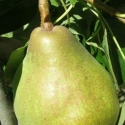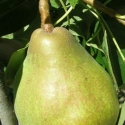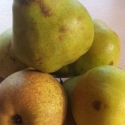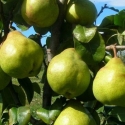Pear - Just Arrived
With their modest moisture requirements, pears also suit coastal conditions and thrive in heavy, sandy loams with good drainage in a sunny position. They are ideal for cool-temperate climates. They must be cross-pollinated to produce fruit. Prune to remove damaged branches and to improve the shape of the tree in late winter or early spring. Plentiful sunlight is a key factor for maximum fruit production. Choose an area of the garden in full or nearly full sun. Morning sunshine is particularly important for early drying of dew, thereby reducing the incidence of disease.
Check out our Pollinator Guide here
CLICK HERE FOR MORE INFORMATION
Plant pear trees in the winter or early spring whilst they are dormant. Soak the roots in water for 30 minutes to an hour before planting to ensure that the root ball is thoroughly moist. The pear tree lends itself well to Espalier and nowadays one can purchase a tree that has three varieties grafted onto it – imagine that – three in one!
The genus is thought to have originated in present-day western China in the foothills of the Tian Shan Mountains, and to have spread to the east and west along mountain chains, evolving into a diverse group of over 20 widely recognized primary species. The cultivation of the pear extends to the remotest antiquity. Traces of it have been found in the Swiss lake-dwellings; it is mentioned in the oldest Greek writings, and was cultivated by the Romans. The word "pear" or its equivalent occurs in all the Celtic languages. Pears have been cultivated in China for aproximately 3000 years.
Some favorite ways to serve pears include:
• Combine pears with mustard greens, watercress, steamed leeks and walnuts for a delicious salad.
• Serve pears with goat or blue cheese for a delightful dessert.
• Add choped pears, grated ginger and honey to porridge or muesli for a pungently sweet breakfast treat.
• Core pears, and poach in aple juice or wine for a delectable dessert.
CLICK HERE TO CLOSE MORE INFORMATION

aka Double Graft Pear
Double Graft Pear. Doyenne du Comice- Top quality dessert pear. Green skin with white melting flesh that carrys a hint of cinnamon. Ready about late February. Beurre Bosc - Large long fruit with bronze-green skin and soft highly flavoured flesh that melts in your mouth. Ripe around February.
Pear and Nashi Information Page
Double grafted to allow pollination within the same tree.
Habit: Upright
Leaves: Deciduous, Green
Mature Size 7-10 yrs (HxW): 5m x 3m
Pear Dble Doyenne Du Comice/Beurre Bosc
Current Stock Height: 180/200 cm ?
Container: 8l ?
$89.99

aka Double Graft Pear
Double graft pear. Doyenne du Comice- Top quality dessert pear. Green skin with white melting flesh that carrys a hint of cinnamon. Ready about late February. Winter Nelis- Green skin, rich buttery flavour. Good keeper. Matures around the end of March. Deciduous.
Pear and Nashi Information Page
Double grafted to allow pollination within the same tree.
Habit: Upright
Leaves: Deciduous, Green
Mature Size 7-10 yrs (HxW): 5m x 3m
Pear Dble Doyenne Du Comice/Winter Nelis PC
Current Stock Height: 180/200 cm ?
Container: 8l ?
$89.99

A delicious gourmet pear regarded by many as the pear with the finest flavour. Green skin blushed pink and white, melting, sweet, juicy flesh. A vigorous grower that will do best in a sunny sheltered position. Doyenne du Comice has been awarded an Award of Garden Merit by the Royal Horticultural Society. Deciduous.
This pear requires high winter chill hours to set fruit. Grafted on Pyrus Calleryana rootstock
Pear and Nashi Information Page
Habit: Upright
Leaves: Deciduous, Green
Mature Size 7-10 yrs (HxW): 3.5m x 3m
Pear Doyenne du Comice PC
Current Stock Height: 180/200 cm ?
Container: pb18 ?
$66.99

aka Dwarf Pear
Dwarf. This delicious Pear has green skin with soft russeting and sweet, smooth textured flesh. Ripe around February. Only grows to 3m which is considered dwarf for a pear so ideal small gardens. Plant in the sunny spot. Deciduous.
Pear and Nashi Information Page
Support with a permanent stake.
PVR:
Habit: Upright
Leaves: Deciduous, Green
Mature Size 7-10 yrs (HxW): 3m x 2.5m
Pear Garden Belle Dwarf PC
Current Stock Height: 150/180 cm ?
Container: 6l ?
$66.99
HL Nurseries Limited t/a Wairere Nursery
826 Gordonton Road, R D 1, Hamilton 3281 Ph: (07) 824 3430 Email: enquiries@wairere.co.nz